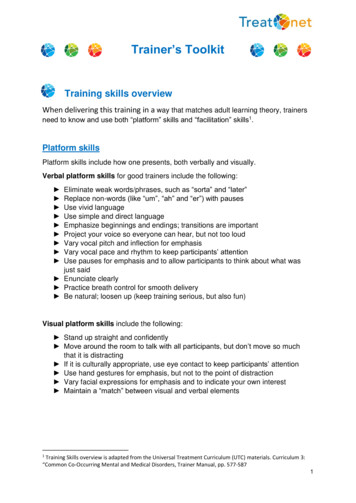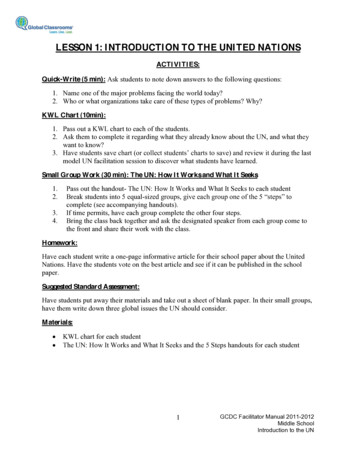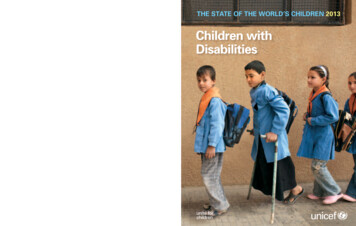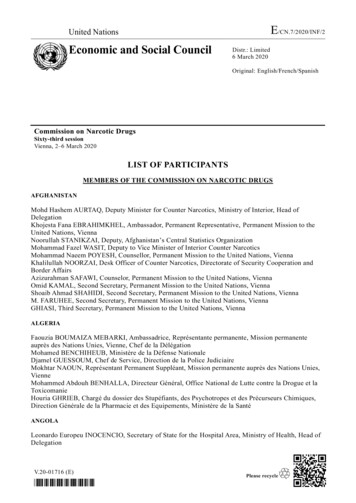
Transcription
Trainer’s ToolkitTraining skills overviewWhen delivering this training in a way that matches adult learning theory, trainersneed to know and use both “platform” skills and “facilitation” skills1.Platform skillsPlatform skills include how one presents, both verbally and visually.Verbal platform skills for good trainers include the following: Eliminate weak words/phrases, such as “sorta” and “later”Replace non-words (like “um”, “ah” and “er”) with pausesUse vivid languageUse simple and direct languageEmphasize beginnings and endings; transitions are importantProject your voice so everyone can hear, but not too loudVary vocal pitch and inflection for emphasisVary vocal pace and rhythm to keep participants’ attentionUse pauses for emphasis and to allow participants to think about what wasjust said Enunciate clearly Practice breath control for smooth delivery Be natural; loosen up (keep training serious, but also fun)Visual platform skills include the following: Stand up straight and confidently Move around the room to talk with all participants, but don’t move so muchthat it is distracting If it is culturally appropriate, use eye contact to keep participants’ attention Use hand gestures for emphasis, but not to the point of distraction Vary facial expressions for emphasis and to indicate your own interest Maintain a “match” between visual and verbal elements1Training Skills overview is adapted from the Universal Treatment Curriculum (UTC) materials. Curriculum 3:“Common Co-Occurring Mental and Medical Disorders, Trainer Manual, pp. 577-5871
Facilitation skillsRather than simply providing information and giving answers to questions, facilitatingtrainers create a positive and productive environment that supports learning. Thegood facilitator: Defines his or her role for participantsIs positiveDoesn’t judgeFocuses participants’ energy on a taskSuggests methods or procedures for accomplishing the taskProtects individuals and their ideas from attackHelps find win/win solutions by seeking agreement on problems and processGives everyone an opportunity to participateResists the temptation to give immediate advice and offer solutions byredirecting questions back to the group Is not afraid to make mistakesEffective communication skills for facilitators include: Listening with full focus on the speakerFocusing the training group’s attentionRecognizing g silence appropriately2
Dealing with difficult participants during trainingDuring training, you may encounter participants who display difficult or challengingbehaviour2. As the trainer, you have the responsibility for ensuring a comfortable andsafe environment for the other members of the group. Remember the followingpoints: Project confidence and good humourBe preparedDon’t take it personallyUse effective communication skillsAvoid an authoritarian/lecturing approachHave clear guidelines for the group Avoid sarcasmBe patient and politeRedirectAssess whether you need to change your approachIgnore “bad” attitudesYou will encounter a range of learning styles across the group. If possible, try toestablish the expectations of the participants and incorporate different strategies tomeet these expectations in a range of ways to engage all learning styles.Prevention and early interventions Make the environment comfortable and the programme interestingExplore participants’ motivations for being in the groupEstablish group rules and boundariesInvolve participants in decision-makingEstablish a positive relationship and encourage relationships in the groupmodelling Aim your intervention at the behaviour and consequences not at the person(same principle applies for groups and individuals) The intention is not to apportion blame, it is to resolve the problem2Dealing with difficult participants during training is adapted from the Universal Treatment Curriculum (UTC)materials. Curriculum 3: “Common Co-Occurring Mental and Medical Disorders, Trainer Manual, pp. 577-5873
Coping strategies Assess the situation; keep yourself and participants safe Ignore negative or non-damaging behaviour Remain calm; don’t argue with the other person or make accusations; bediscreet Avoid ultimatums Use active listening skills to check your understanding of the situation Refer back to group rules set up at the beginning of the session. Whatbehaviour will or will not be accepted; and don’t get pushed beyond this limit Be persistent and consistent in your response, which conveys to the difficultperson that you mean what you say Provide an opportunity for time out or a private chat Believe in yourself and your ability to deal with others Look for ways to reduce the causes of the behaviour Monitor the effectiveness of your coping strategy, modifying it whereappropriate Assess the impact on others Seek advice if necessaryDealing with difficult behaviour can be emotionally tiring. Caring for yourself duringthis time is vital to the effective management of the situation: Recognize the effect an interaction has on youAllow yourself recovery timeBe aware of things that help you recover effectively and quicklyUse your co-trainer for support4
BehaviourPossible ReasonsThe participant is:The participant may be:What to do Interrupt with “That’s an interesting point. Let’s see whateveryone else thinks.” Directly call on others Suggest, “Let’s put others to work.” When the person stops for a breath, thank him or her,restate pertinent points and move on.Overly talkative – to theextent that others do nothave an opportunity tocontribute Argumentative, to theextent that others’ ideasor opinions are rejectedor others are treatedunfairly Be seriously upset about the issue underdiscussion Be upset by personal or job problems Be intolerant of others Be lacking in empathy Be a negative thinker Keep your temper in check. Try to find some merit in what is being said; get thegroup to see it, too; then move on to something else. Talk to the person privately and point out what his or heractions are doing to the rest of the group. Try to gain the person’s cooperation. Encourage the person to concentrate on positives, notnegatives.Engaging in sideconversations withothers in the group Be talking about something related to thediscussion Be discussing a personal matter Be uninterested in the topic underdiscussion Direct a question to the person. Restate the last idea or suggestion expressed by thegroup and ask for the person’s opinion.Unable to expresshimself or herself sothat everyoneunderstandsAn “engager beaver”Exceptionally well informedNaturally wordyNervous Rephrase, restating what the person said and asking for Be nervous, shy, excitedconfirmation of accuracy. Not be used to participating in discussions Allow the person ample time to express himself orherself. Help the person along without being condescending.5
Always seekingapproval Be looking for advice Be trying to get the trainer to support hisor her point of view Be trying to put the trainer on the spot Have low self-esteem Avoid taking sides, especially if the group will be undulyinfluenced by your point of view. Show support without favouritism.Bickering with anotherparticipant. Carrying an old grudge Feeling very strongly about the issue Emphasise points of agreement and minimise points ofdisagreement Direct participants’ attention to the objectives of thesession Mention time limits of the session Ask participants to shelve the issue for the momentUninvolved andunwilling to commit tonew tasks Be lazy Be too busy already Feel he or she should not have beenmade to attend the session in the firstplace Be unaware of his or her own skills andabilities Ask the person to volunteer for tasks (others in groupmust volunteer as well). Clearly explain the purpose of the training and thebenefits to individuals and the organization. Identify how the outcomes can be applied in theworkplace. Privately ask why the person won’t become involved andis unwilling to commit to new tasks. Provide constructive feedback and provide reassuranceand encouragement6
Icebreakers and energisersThe purpose of icebreakers3 if to create interaction among participants and reducetension. This activity is optional but highly recommended in the beginning of everymodule and, if time allows, every workshop. Icebreakers help motivate and involveparticipants at the beginning of a training session, by introducing a fun exercise thatrequires them to interact.Getting to know each otherPostcards / Colour cards1. Prepare a set of postcards and cut them into 4/5/6 even pieces (depending onthe number of participants required for group work), but each participant tohave one.2. Distribute the pieces among participants before asking them to find thematching parts and to form a whole post card.3. Alternatively, groups can be formed according to colour (i.e., give them adifferent coloured piece of card or paper for as many small groups as need tobe formed).To use this exercise at the first session as an icebreaker: Once everyone has found the group, ask participants to introduce themselvesor to get to know each other further and each of them to share oneinteresting/fun fact about themselves.Nametags (1)Materials: Markers, flip chart paper, big cards/signs, postcards, colour cards, whitesheets of paper for biographies, Polaroid camera, film.Time: 30 minutesName tags are useful and can be made more interesting with Polaroid photos.1. Choose someone to take a snapshot of each participant as participants arriveat the workshop venue.2. Give a blank sheet of paper to each participant and invite that person to writeinformation to share with others.3. Their photos will be pasted on the written sheets and exhibited on a panel.3Most of the icebreakers on this list are adapted from Guiding the Recovery of Woman (GROW), TrainerManual, pp. 371-386.7
Nametags (2)The trainer prepares a name tag for each participant and places the name tags in abox. Each participant picks a nametag from the box. Participants locate the personwhose name tag they drew and introduce themselves. (This is especially useful forlarger groups—20 or more.)Unique CharacteristicsEven if participants already know each other, the trainer must get to know them.Instead of asking participants to say their names, the trainer can divide the group intopairs and give participants a few minutes to interview each other. Then, participantsshould introduce their partners by name and share at least two unique characteristicsabout them.Your Favourite ThingsThe trainer divides the group into pairs and asks participants to tell each other theirfavourite food or to name the animal they feel best describes them and why. Thisinformation is shared with the group when participants introduce their partners.Ball TossParticipants and the trainer form a circle and toss a softball around the circle.Participants state their names as they catch the ball. After a few minutes, when theycatch the ball, they call out the name of the person who tossed it to them. Thisactivity can also be used throughout the course by substituting a quick informationexchange for people’s names. For example, the trainer may ask, “What are someChallenges that women face when getting substance abuse treatment?” The ball istossed around the circle, and participants call out a different barrier as they catch theball.Three QuestionsParticipants write down three questions and find someone in the room they do notknow well. Each participant then asks questions of the other. The participants thenintroduce their partners to the group by sharing both the questions and the answers.8
Find the Missing PieceThe trainer prepares pieces of paper, enough for everyone in the group. The papersinclude words that are split into two, for example:COCOA BUTTERMILE STONEICE CREAMEach person picks one piece of paper and then begins to look for the person whohas the matching word. After finding the match, the participants should get to knowthe other person. Then, they will be asked to introduce one another to the rest of thegroup.Fact or FictionParticipants write down four facts about themselves, one of which is not true. Eachperson takes turns reading the list aloud, and the rest of the group writes down theone they think is not true. When everyone has finished reading, the first person readsthe list again and identifies the fact that is not true. Participants should compare theirwritten responses with the correct answers.Everyone’s a Liar1. The trainer writes three statements on the board. Two statements are true,and one is false. Example:I have been training for 10 years.I have a pet dog called, “Dog.”I lived in Switzerland for a year.2. The participants ask “lie detector” questions to get further information, so theycan determine which statement is false. Example:Training: Where have you conducted training? What have you taught?What year did you start?Pet: How old is Dog? What does Dog eat? Where do you keep Dog?Switzerland: Where did you live in Switzerland? What language wasspoken in that part of Switzerland?3. Participants vote on which statement is a lie. The trainer reveals the true andfalse statements.4. Place participants in small groups (three or four per group works well). Smallgroups repeat the steps. Have participants introduce each other to the largegroup.9
MaroonedDivide the participants into teams. Ask participants to pretend they are marooned onan island. Have the teams choose five (the trainer can use a different number, suchas seven, depending on the size of each team) items they would have brought withthem if they had known there was a chance that they might be stranded.Note that they are only allowed five items per team, not per person. Ask each team towrite their items on a flip chart and discuss and defend their choices with the wholegroup. This activity helps them to learn about other’s values and problem-solvingstyles and promotes teamwork.What Do We Have in Common?Split the participants into pairs. Each pair will have 30 seconds to think of five thingsthey have in common. At the end of the 30 seconds, put two pairs together and givethe group a minute to find something all four participants have in common Finally,each group can present the list of things they have in common.Tell Us About YourselfPass around a bag of candy. Tell the participants to take as many as they want.Once all the participants have candy, tell them that for each candy they took theyshould say one thing about themselves. For instance, if a participant took 10 candies,they would have to say 10 things about themselves.Work and training related icebreakersBall Toss BrainstormingAnnounce a topic (things associated with a topic, a holiday, the course content etc.)Then, toss around a ball. When someone catches the ball, that person shouts outsomething related to the topic and then tosses the ball to someone else. Continuethe exercise until everyone has had a chance to speak.Variations:When they catch the ball, participants tell what they thought the most importantlearning concept was. Continue the exercise until everyone has caught the ball atleast once and explained an important concept of the material covered in theprevious workshop(s).Each person tells one step of a process or concept when the ball is tossed to them.The trainer or participant, in turn, writes it on a chalkboard or flip chart. For example,after covering “client assessment,” the trainer would start the ball toss by havingeveryone give one step in the client assessment process.10
The Magic WandAsk the participants what they would do if they just found a magic wand that allowsthem to change three work-related activities. They can change anything they want.How would they change themselves, their job, their supervisor, those they work with,an important project, and so forth? Have the participants discuss why it is importantto make the change.Another variation is to have them discuss what they would change if they became thesupervisor for a month. This activity helps them to learn about others’ desires andfrustrations.Finish the SentenceAsk each person to complete one of these sentences (or something similar):The best job I ever had was. . .The worst project I ever worked on was. . .The riskiest thing I ever did was. . .When you want everyone to introduce themselves at the beginning of a training, youcan have them complete:I am in this course because. . .Calm Down!Sometimes participants need to calm down or “come down” to reality after someintensive material presented. Also, to get the full benefit of new material, some“introspective time” is needed.Have the participants lay their heads on the table or get in a comfortable position.Then, have them reflect on what they have just learned. After about 5 minutes, say akey word or short phrase and have them reflect on it for a couple of minutes. Repeatone or two more times then gather the group into a circle and have them share whatthey believe are the most important points of the concept and how they can best useit at their place of work.Note: This may seem like a waste of time to many, but reflection is one of the mostpowerful learning techniques available.11
Drugs in my countryThis icebreaker is most appropriate if participants are from different countries. If thenumber of participants is relatively small (about ten), the trainer may just ask themthe following questions:What is the main consumed drug in your country?What are the main problems that this drug is creating amongpeople in your country?If participants are predominantly from one country, the trainer may adapt questions,for example, like this:What type of drugs do your clients consume?What are the main problems that these drugs create amongpeople in your city/town/village/community, etc.?Alternative for a group with a larger number of participants:Divide participants into the groups of 4-6 people and ask to share their opinion andexperience about the two questions first in a group and then report to all participantsa short summary.EnergisersAn energizer4 is a brief activity that is intended to increase energy in a group byengaging them in physical activity, laughter, or in ways that engage the memberscognitively (problem-solving). They can be used with any group, including duringtraining. Some energizers are cooperative; some are competitive. It is best to useeach type and to base your choice on the mood and functioning of the group.The CarrotAsk participants to stand up and move to the end of the room.Tell them that you will name a list of things that might be motivating or not to them atthe current moment. They should choose to move, or not, depending on howmotivating that thing is for them. If they move, they can move from 1 to 3 stepsforward (1 step if it is a little motivating, 3 steps if it is very motivating to them). Theyalso may choose to move back (1 step if it is a little discouraging to 3 steps if it is verydiscouraging).4Definition taken from http://thetrainingworld.com/resources/Training Methods and Activities/Energizers/12
As an alternative, you could ask each participant to name something that ismotivating for them and then have group members respond.For example, motivating things the trainer could name:water, ice-cream, donuts, coffee, tea, getting news of an extra day of vacation, 10(cash), playing with your child, hugging your best friend, learning something new foryour career, dancing, meeting new people, etc.Once the trainer has named around 8-10 items, ask participants to observe theirpositions in the room, and have them reflect on how rewards have different effects oneach of us.Balloon juggle and sort5Supplies: Balloons (one per person)Challenge participants to keep all balloons in the air. This gets the group moving andcooperating. Once participants get the hang of it, make it harder by adding moreballoons, placing restrictions (e.g., no hands to keep balloons up), or askingparticipants to keep juggling the balloons.Balloon franticSupplies: Balloons (two or three per person) , stopwatch or watch with a secondhand.Give each person one balloon, with the rest in a nearby pile. Everyone beginsbouncing the balloons in the air. Every 5 seconds, another balloon is added. See howlong the group can keep the balloons bouncing before it receives six penalties. Apenalty is announced loudly (to create stress!) by the energizer leader when aballoon hits the floor (or, once on the floor, if it is not back in play within 5 seconds).The leader keeps a cumulative penalty score by shouting out “one,” “two,” and so on.When the leader calls “six,” time is stopped. After some discussion, the group tries toimprove its record with another attempt.Chicken stretchIMPORTANT!! Do not reveal the name of this activity until afterward! It relies on anelement of surprise.Have participants form a circle and explain that it is important to warm up one’s bodyfrom head to toe before participating in physical games and activities. Starting withlegs, ask people to try to get one of their knees to touch their chin. Try each leg5Energisers on this and the next page are adapted from the Universal Treatment Curriculum (UTC) materials.Curriculum 3: “Common Co-Occurring Mental and Medical Disorders, Trainer Manual, p. 57713
alternately. Ask for 10 knee-to-chin touches. It is not easy: some can do it, manycan’t.Then move on to the arms. One side at a time, stick a thumb under the armpit andmove the elbow up and down and do a side stretch. Do this three times on each side.Then explain that it’s important to warm up one’s vocal cords for group games. Grabthe skin on your neck to demonstrate and waggle it side to side. Ask for someguttural noises, as much as possible; then ask for some animal noises.Finally, have participants put it all together — walking around raising knees in air,flapping both arms, and making animal noises (at some point start encouraging thechicken noises), and you have a clucking and squawking chicken yard. Very funny.Simon saysThe trainer is “Simon” (use your own name). “Simon” instructs participants to followhis or her instructions, but ONLY if he or she says “Simon says” first. Simon can havethe group do anything possible and safe (e.g., “Simon says raise your right leg” or“Simon says turn in a circle”). If a participant follows an instruction made without“Simon says” preceding it or doesn’t follow a “Simon says” instruction, that participantis out. Continue the game until four or five participants are out, then stop the game,and have the group come up with a “punishment” for those people.Animal Crackers6Place participant’s chairs in a large circle and ask them each to take a seat. Stand inthe middle of the circle and explain that you are now going to demonstrate threedifferent types of animals to the group.Elephant – Hold shoulder of one arm against nose and wave it at the floor.Monkey – Hold each ear and puff out cheeks.Alligator – Place both arms out in front of you and clap your palms together, up anddown in a snapping motionExplain that you will go around the group and point to a person. That person mustimmediately take the shape of an elephant (as above), while the person to the right ofthem takes the shape of a monkey and the person to the left takes the shape of analligator.The person out of the three that is slowest to take the correct shape loses and mustcome to the centre of the room and start the process again.The game ends when you feel that enough people have been involved in the processand the energy levels are raised. This energiser causes much laughter and is greatfor re-energising a group.6Energiser from ckers/14
When delivering this training in a way that matches adult learning theory, trainers need to know and use both "platform" skills and "facilitation" skills1. Platform skills Platform skills include how one presents, both verbally and visually. Verbal platform skills for good trainers include the following:











